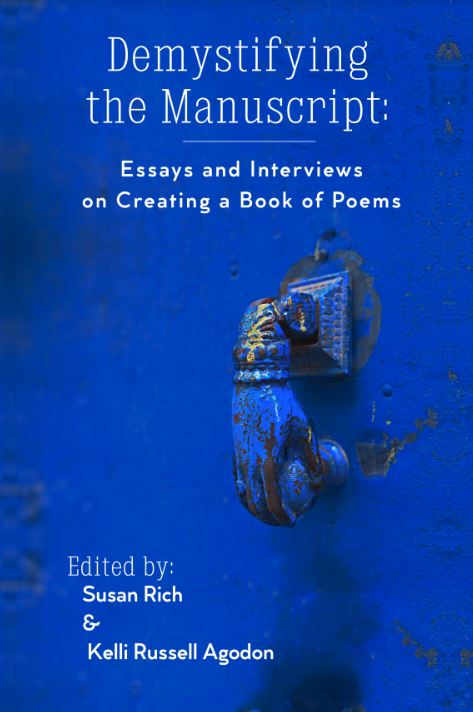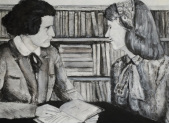Demystifying the Manuscript: Essays and Interviews on Creating a Book of Poems
Book creation is an art and Demystifying the Manuscript shares many perspectives on how to put together a book of poems through the essays and interviews of contemporary prize-winning poets and editors. While there isn’t a single “correct” method for creating a book of poems, Demystifying the Manuscript is filled with expert advice on all aspects of manuscript creation: ordering your poems, determining your goals, insider tips from the editors of journals and small presses, and everything in between. Demystifying the Manuscript will guide you through the process of creating your best book of poems whether you are an emerging writer or an established poet.
Book creation is an art and Demystifying the Manuscript shares many perspectives on how to put together a book of poems through the essays and interviews of contemporary prize-winning poets and editors. While there isn’t a single “correct” method for creating a book of poems, Demystifying the Manuscript is filled with expert advice on all aspects of manuscript creation: ordering your poems, determining your goals, insider tips from the editors of journals and small presses, and everything in between. Demystifying the Manuscript will guide you through the process of creating your best book of poems whether you are an emerging writer or an established poet.
Sample Excerpt:
A Self-Help Guide for Getting Along with Your Manuscript
~Melissa Studdard
A manuscript is a love and a crush. You wake in the middle of the night thinking about it, delighted, frustrated, alternately and unpredictably elated and insecure. Though you know you need to give it space, you sometimes feel the shameful urge to smother and control it. In some ways, this relationship feels similar to others you’ve had or heard about, yet it’s also wholly unique. Such are the woes and joys and mysteries of love. But as anyone who has seen a good counselor knows, there are universal, practical strategies that can apply to even the most seemingly individualized and fervid situations.
Listen:
First and foremost, listen to what your poems are telling you. It may seem easier to wrangle them into formation, but like any other curious creatures, as soon as you get them lined up, they’re going to pop out and have to be coaxed back in. Trust me, it’s easier to just start with negotiation and compromise. Ask the poems what they want. You may have created them, but they’ve taken on their own lives now, and they have both intelligence and personality.
Fan them out and see how they look in conversation with each other. And I really do mean fan them out. At this stage, it’s important to bring them from the screen to the physical world where you can bodily move them around. This may look slightly different from one manuscript or person to the next—maybe you’ll sit circled by them on the floor; maybe you’ll tack them all over a wall and move them around for a week or a month. The critical things are that you start to view them as objects that can be relocated, and that you live with them in your literal space for a time. In the same way that you can sit staring at the computer for hours with no idea what to write and then find yourself flooded with ideas as soon as you start vacuuming, you can also walk past the poems on your way to the bathroom and suddenly see a pattern emerge. The longer you can keep them in your physical space, the more you will see...
~Melissa Studdard
A manuscript is a love and a crush. You wake in the middle of the night thinking about it, delighted, frustrated, alternately and unpredictably elated and insecure. Though you know you need to give it space, you sometimes feel the shameful urge to smother and control it. In some ways, this relationship feels similar to others you’ve had or heard about, yet it’s also wholly unique. Such are the woes and joys and mysteries of love. But as anyone who has seen a good counselor knows, there are universal, practical strategies that can apply to even the most seemingly individualized and fervid situations.
Listen:
First and foremost, listen to what your poems are telling you. It may seem easier to wrangle them into formation, but like any other curious creatures, as soon as you get them lined up, they’re going to pop out and have to be coaxed back in. Trust me, it’s easier to just start with negotiation and compromise. Ask the poems what they want. You may have created them, but they’ve taken on their own lives now, and they have both intelligence and personality.
Fan them out and see how they look in conversation with each other. And I really do mean fan them out. At this stage, it’s important to bring them from the screen to the physical world where you can bodily move them around. This may look slightly different from one manuscript or person to the next—maybe you’ll sit circled by them on the floor; maybe you’ll tack them all over a wall and move them around for a week or a month. The critical things are that you start to view them as objects that can be relocated, and that you live with them in your literal space for a time. In the same way that you can sit staring at the computer for hours with no idea what to write and then find yourself flooded with ideas as soon as you start vacuuming, you can also walk past the poems on your way to the bathroom and suddenly see a pattern emerge. The longer you can keep them in your physical space, the more you will see...

